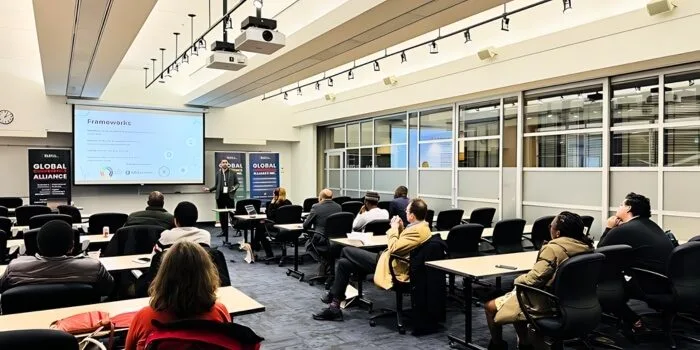Ever wonder about the masterminds behind the persistent flow of talks at your favorite conferences? It’s not just about who speaks, but when they do.
The heart of every successful conference is the roster of speakers, each selected for their unique contributions to the theme. But who decides on speaker order at a conference?
The key lies with the event organizers and a dedicated conference program committee. These folks, armed with expertise in the event’s focus area, sift through proposals to curate a lineup that should be relevant and engaging from start to finish.
Curious to uncover more about this meticulous process? Stick around as we dive deeper into the world of conference planning in our article.
The Hypothesis of A Conference
While starting an adventure without knowing the ins and outs, one will explore uncharted territories. Now diving into the depths of knowledge at a conference is something close to an adventure.

The hypothesis of a conference is similar to the guiding star for this journey. It sets the stage for what the event aims to explore, question, or solve within its realm. The conference host is the captain of the ship. Their job? To ensure that every aspect of the event aligns with this central hypothesis.
From choosing the right speakers to setting the agenda, a professional conference host curates an experience that brings this hypothesis to life, inviting attendees to engage, debate, and contribute. It’s a collaborative quest for understanding, with the hypothesis leading the way.
So, when you next attend a conference, remember, that you’re part of a grand experiment, exploring the bounds of knowledge guided by a carefully crafted hypothesis.
What Is the Objective of A Conference?
At the heart of any conference is the desire to ignite innovation and share knowledge. It’s where experts and devotees gather, eager to exchange cutting-edge ideas and discoveries.
This melting pot of insights fuels inspiration, pushing fields forward. Also, the following key aspects are related to the objectives of a conference.
Networking and Collaboration
Conferences serve as a prime venue for networking. They bring together like-minded individuals from various corners of the globe, offering a golden opportunity to connect, collaborate, and start conversations that could lead to groundbreaking partnerships.
Professional Development
Another key objective is professional development. Attendees get to polish their skills, learn new techniques, and stay updated on industry trends. It’s an investment in personal growth, ensuring participants remain at the top of their game.
Types of Conferences
- Academic Conferences focus on research and scholarly discussions.
- Business Conferences aim at industry trends, strategies, and networking.
- Many in-person technology conferences that showcase the latest advancements, innovations, and future technologies.
Each type of conference, whether academic, business, or tech, aligns its objectives to indulge its audience’s unique interests and professional needs, enriching the community and promoting growth.
How are Core Speakers Selected for a Conference?
The process of making choices about the core speakers for a conference is a bit like assembling a dream team for the ultimate knowledge-sharing league. It’s a meticulous process that ensures the event not only educates but also inspires attendees. Let’s dive into the steps involved in this crucial selection.
Step 1: Call for Proposals
The journey often begins with a call for proposals. Organizers announce the conference theme and invite experts to submit their ideas for talks or presentations. This open invitation ensures a diverse pool of potential speakers.
Step 2: Review and Evaluation
Next up, a specialized committee reviews these proposals. They’re looking for innovation, relevance to the conference theme, and the potential impact on the audience. It’s not just about the idea, though; the speaker’s background and public speaking skills are under the microscope too.
Step 3: Invitations to Industry Leaders
For those slots not filled through proposals, organizers might directly invite renowned industry leaders. These are the heavy hitters, known for their expertise and ability to draw a crowd. Their inclusion adds prestige and attracts a wider audience.
Step 4: Diversity and Inclusion
An essential step in the process is ensuring diversity and inclusion. Organizers strive for a lineup that reflects varied perspectives, backgrounds, and areas of expertise. This enriches the conference, providing a more comprehensive and inclusive experience for attendees.
Step 5: Final Selection
With all factors considered, the committee makes its final selections. They’re crafting a balanced program that offers a mix of emerging voices and established experts, covering a broad spectrum of topics within the conference’s theme.
Step 6: Confirmation and Announcement
The selected speakers are contacted to confirm their participation. Once confirmed, the organizers announce the lineup, drumming up excitement and anticipation for the event.
This selection process is a blend of strategy, inclusivity, and a keen eye for talent. It ensures that the conference not only covers the theme from multiple angles but also provides a platform for learning, inspiration, and networking.
Who Decides on Speaker Order at A Conference?
At the seamless flow of speakers at a conference one may find themselves marveling, where each talk seems to perfectly complement the next? It’s no accident but the result of careful planning and strategic decision-making.
The burning question, “Who decides on speaker order at a conference?” unveils a behind-the-scenes look at the orchestration involved in creating an engaging and impactful event.
The response lies with the event organizers and a dedicated committee, whose collaborative efforts ensure that attendees commence on a coherent and stimulating journey throughout the conference. Let’s dive deeper into the mechanics of this process and uncover the layers involved in deciding the speaker lineup.
Event Organizers: The Maestros of Planning
At the helm of the decision-making process are the event organizers. These individuals or teams have the ultimate responsibility for the conference’s overall success. Their role involves overseeing every aspect of the event, from conceptualization to execution. When it comes to speaker order, organizers work closely with other key players to design a program that maximizes engagement and educational value.
Conference Program Committee: The Curators of Content
Integral to the decision-making are the members of the conference program committee. This group, often comprising experts in the conference’s focal area, brings a wealth of knowledge and insight to the table. They evaluate proposals, assess speaker qualifications, and consider the thematic flow of the event. Their goal is to assemble a lineup that not only covers the breadth of the subject matter but also resonates with the audience’s interests and needs.
Strategic Considerations for Speaker Order
Here are some of the strategies that organizers apply for the process of the speaker’s order in a conference.
Relevance and Flow
The committee prioritizes a logical progression of topics, ensuring that each session builds on the previous one or complements it in a way that enhances understanding and retention.
Speaker Availability
Practical aspects, such as speakers’ availability, can influence the order. Organizers strive to accommodate scheduling constraints while maintaining the integrity of the conference’s flow.
Audience Engagement
Time of day is a crucial factor. High-energy speakers or keynotes are often scheduled during prime times to keep energy levels high and attendees engaged.
Diversity and Balance
A concerted effort is made to reflect diversity in perspectives, backgrounds, and expertise throughout the event. This balance stimulates a more inclusive and enriching experience for attendees. The decision to set speaker order at a conference is a collaborative and strategic process involving event organizers and the program committee.
Together, they craft an experience that aims to educate, inspire, and engage, ensuring that each speaker’s placement in the lineup contributes to the event’s overarching goals and themes. This meticulous planning is what transforms a series of presentations into a cohesive and memorable conference journey.
Does the Order Have Any Chronological Perspective?
Yes, the order of speakers at a conference often has a chronological perspective, but not always in the sense of time. Let’s break it down.
Thematic Progression
The chronological aspect often pertains to the thematic progression of the conference. Organizers meticulously plan the speaker lineup to ensure that the content unfolds in a logical and engaging manner. This approach guides attendees through a narrative or educational journey, moving from introductory topics to more complex discussions as the event progresses.
Event Dynamics
The dynamics of the event also play a crucial role. Keynote speeches typically book the conference, serving as impactful openings and closings. Meanwhile, breakout sessions and panels might be interspersed to maintain interest and energy levels. This intentional structure ensures that the event’s momentum is sustained from start to finish, providing a satisfying and comprehensive experience for all participants.
Does the Order Really Matter for A Successful Conference?
Yes, the order absolutely matters for a successful conference. It’s the backbone of how smoothly and effectively the event unfolds. Let’s dive into why it’s so crucial.
Impact on Audience Engagement
The right order keeps the audience hooked from start to finish. Placing high-energy talks at strategic points, such as right after lunch, can reinvigorate the crowd. Similarly, scheduling sessions in a way that builds upon previous knowledge enhances learning and keeps attendees engaged throughout the event.
Flow and Cohesion
A thoughtfully planned order ensures a seamless flow, creating a cohesive narrative or thematic arc. This makes the conference not just a series of talks, but a comprehensive journey that enriches the attendee’s experience. It allows for a natural progression of ideas, facilitating a deeper understanding and connection with the content.
FAQs
The ins and outs of conference planning can spark a lot of questions while surfing in, especially when it comes to organizing speakers and presentations. Let’s dive into some frequently asked questions to shed light on common curiosities and perhaps introduce a few tips you hadn’t considered before.
Who Is the Speaker at The End of A Conference?
The grand finale of a conference often features a closing keynote speaker. This key role is designed to leave a lasting impression, wrapping up the event with a powerful message that encourages attendees to stay engaged right until the very end.
Can You Have 2 Keynote Speakers at A Conference?
Absolutely! It’s not uncommon for conferences to feature two keynote speakers—one to kick off the event with a bang and another to close it on a high note. This duo can help ensure that the conference starts and ends with equally compelling content, keeping attendees motivated throughout.
What Is the 777 Rule in Presentation?
The 777 rule is a golden guideline for presentations, suggesting a maximum of 7 lines of text per slide, no more than 7 words per line, and a total of 7 slides for a 20-minute talk. This rule aims to keep presentations concise and engaging, ensuring that your audience stays tuned in without being overwhelmed by information.
How Does Speaker Selection Impact the Success of A Conference?
Choosing the right speakers and in the right order can significantly impact the success of a conference. It influences the event’s flow, attendee engagement, and overall satisfaction. A well-thought-out speaker lineup can transform a good conference into an unforgettable one, by providing a mix of insights, inspiration, and networking opportunities.
Final Thought
So, we’ve maneuvered the intriguing world of conference organization, shedding light on the crucial role that speaker order plays. It’s clear that the event organizers and the conference program committee hold the reins when it comes to deciding who speaks and when.
This strategic decision, “Who decides on speaker order at a conference?”, impacts not just the flow of the event but also its overall success, ensuring that attendees leave with valuable insights and connections.
For those organizing or participating in conferences, remember that a well-planned speaker lineup is key to engaging your audience from start to finish. And for the travelers among us, always plan ahead to make the most of your conference experience, from booking accommodations early to exploring the host city.







